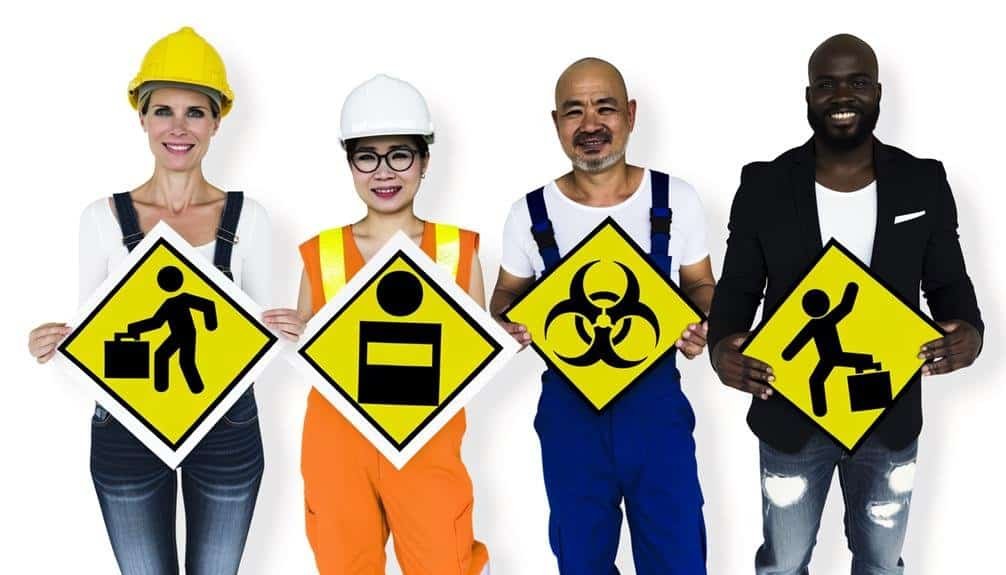Who Has Hazard Communication Duties?
Are you aware that hazard communication duties are not only limited to employers, but extend to a variety of individuals within the workplace?
It's not just the employers who have the responsibility to ensure the safety of their employees. Supervisors, safety coordinators, and hazard communication program managers also play a crucial role in maintaining a safe working environment.
And let's not forget about the employees themselves, who have their own set of duties when it comes to hazard communication.
But what exactly do these duties entail? Well, continue on and you'll find out.
Key Takeaways
- Employers have the responsibility to provide comprehensive training on hazardous chemicals and implement a written hazard communication program.
- Supervisors play a crucial role in receiving training on hazard communication regulations, ensuring proper use of personal protective equipment (PPE), and inspecting work areas for potential hazards.
- Safety coordinators are responsible for implementing safety training programs, identifying and assessing potential hazards, and maintaining safety data sheets and proper labeling of hazardous chemicals.
- The hazard communication program manager is responsible for developing and maintaining a comprehensive hazard communication program, conducting hazard assessments, providing training to employees, and regularly reviewing and updating hazard communication policies and procedures.
Employers
As an employer, you have specific duties under hazard communication regulations to ensure the safety and well-being of your employees. Your obligations include:
- Providing comprehensive training on hazardous chemicals
- Implementing a written hazard communication program
- Maintaining safety data sheets (SDS) for all chemicals in the workplace
It's your responsibility to:
- Label all hazardous substances correctly, ensuring that employees can easily identify and understand the potential risks
- Inform your employees about the hazards associated with the chemicals they work with, as well as the necessary safety precautions
It's crucial to regularly:
- Review and update your hazard communication program to ensure compliance with the latest regulations
Supervisors
Supervisors play a crucial role in ensuring compliance with hazard communication regulations and maintaining a safe work environment for their employees. They have specific duties and responsibilities that contribute to the overall effectiveness of hazard communication programs.
Here are key points regarding supervisor training and accountability:
- Supervisor training:
- Supervisors must receive training on hazard communication regulations, including the identification and labeling of hazardous chemicals in the workplace.
- They should understand the importance of providing employees with access to safety data sheets (SDS) and the proper use of personal protective equipment (PPE).
- Supervisor accountability:
- Supervisors are responsible for ensuring that employees understand hazard communication procedures and follow them correctly.
- They should regularly inspect work areas to identify any potential hazards and take appropriate corrective actions.
- Supervisors must enforce safety protocols and provide feedback and guidance to employees to maintain a safe work environment.
Safety Coordinators
Safety Coordinators play a vital role in maintaining a safe work environment and ensuring compliance with hazard communication regulations. They're responsible for implementing safety training programs and ensuring that all employees receive the necessary education and training on hazards and safety procedures.
Safety Coordinators work closely with supervisors and employees to identify and assess potential hazards in the workplace. They conduct regular inspections and audits to identify any potential risks and develop strategies to mitigate them.
Additionally, Safety Coordinators are responsible for maintaining and updating safety data sheets and ensuring that all hazardous chemicals are properly labeled.
Hazard Communication Program Managers
Hazard Communication Program Managers oversee the implementation and enforcement of hazard communication policies and procedures in the workplace. They play a crucial role in ensuring that the organization complies with hazard communication program implementation requirements.
As a Hazard Communication Program Manager, your responsibilities include:
- Developing and maintaining a comprehensive hazard communication program that aligns with regulatory standards.
- Conducting hazard assessments to identify potential workplace hazards and implementing appropriate control measures.
- Providing hazard communication training to employees, ensuring they understand the hazards associated with their work and how to protect themselves.
- Maintaining up-to-date safety data sheets (SDSs) and labels for hazardous substances used in the workplace.
- Regularly reviewing and updating hazard communication policies and procedures to reflect changes in regulations or best practices.
Employees
Employees play a vital role in maintaining a safe and compliant workplace environment. They're responsible for following hazard communication procedures to ensure workplace safety.
Employee training is essential in ensuring that employees are aware of the potential hazards they may encounter in their work environment, as well as the necessary precautions to take. This training includes educating employees about the proper use of personal protective equipment (PPE), understanding safety data sheets (SDS), and knowing how to interpret hazard labels.
Conclusion
You, as an employer, supervisor, safety coordinator, or hazard communication program manager, bear the daunting responsibility of ensuring the safety of your employees. With hazardous substances present in the workplace, it's crucial to effectively communicate the associated risks and necessary precautions.
By fulfilling these duties, you become the guardian of your employees' well-being, safeguarding them from potential harm. Embrace this vital role, and let your commitment to hazard communication create a workplace that prioritizes safety above all else.





